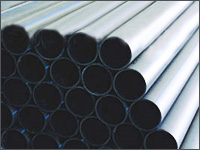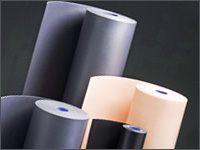| Home > Material > Commonly used Materials > Polyethylene |
Polyethylene |
The scientific definition of Polyethylene is ‘A polymer consisting of long chains of the monomer ethylene processed by polymerization of ethene’. Its common name is Polythene. This is the most commonly and broadly used type of thermoplastic commodity with an annual production of more than 80 million metric tons.
 The main chemical elements of polyethylene are hydrogen and carbon. Different types of polyethylene can be produced through different ways of polymerization, viz.:
The main chemical elements of polyethylene are hydrogen and carbon. Different types of polyethylene can be produced through different ways of polymerization, viz.:
- Radical Polymerization
- Anionic Addition Polymerization
- Ion Coordination Polymerization
- Cationic Addition Polymerization
Description:
The key chemical elements of polyethylene are hydrogen and carbon. As ethene contains no substituent group that act upon the stability of the propagation head of the polymer, polyethylene can be produced through :
- Radical polymerization
- Anionic addition polymerization
- Ion coordination polymerization
- Cationic addition polymerization
Physical Properties:
Melting Point: The Melting Point for Average Commercial Medium and High Density Polyethylene is typically 120 to 130 °C (248 to 266 °F). The Melting Point for Average Commercial Low Density Polyethylene is typically 105 to 115 °C (221 to 239 °F).
Solubility: Unlike the Cross Linked Polyethylene, almost all the other types of polyethylene are soluble at higher temperatures.
Ignition: Polyethylene burns slowly after melting with a blue flame and leaving paraffin odour. Further, it keeps on burning even after removing flame source and creates a drip.
Chemical Properties: The Low, Medium and High Density Polyethylene possess excellent chemical resistance, which means that strong acids or strong bases cannot attack them.
Types of Polyethylene:
There are various types of polyethylene that are categorized into different classes depending upon their density and branching. The characteristics that play a vital role in determining the mechanical properties of polyethylene are crystal structure, type of bonding and the molecular weight.
The most demanded of all are High Density Polyethylene (HDPE), Linear Low Density Polyethylene (LLDPE) and Low Density Polyethylene (LDPE).
 Other Important Types of Polyethylene are:
Other Important Types of Polyethylene are:
- Ultra High Molecular Weight Polyethylene (UHMWPE)
- Ultra Low Molecular Weight Polyethylene (ULMWPE or PE-WAX)
- High Molecular Weight Polyethylene (HMWPE)
- High Density Cross Linked Polyethylene (HDXLPE)
- Cross Linked Polyethylene (PEX or XLPE)
- Medium Density Polyethylene (MDPE)
- Very Low Density Polyethylene (VLDPE)
- Chlorinated Polyethylene (CPE)
|
| |
| |
 |
